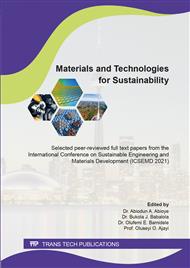[1]
Hach Turbidity Meter (The importance of turbidity meter in drinking water industry, https://support.hach.com/app/answers/answer_view/a_id/1000331/~/why-is-turbidity-important%3F-(2020).
Google Scholar
[2]
C.Y. Teh, P.M. Budiman, K.P.Y. Shak, T.Y. Wu, Recent advancement of coagulation–flocculation and its application in wastewater treatment. Ind Eng Chem Res (2016) 55:4363–4389.
DOI: 10.1021/acs.iecr.5b04703
Google Scholar
[3]
M.S. German, H. Dong, A. Schevets, R.C. Smith, A.K. Sen Gupta, Field validation of self-regenerating reversible ion exchange-membrane (RIX-M) process to prevent sulphate and silica fouling, Desalination. 469 (2019) 114093., https://doi.org/10.1016/j.desal.2019.114093.
DOI: 10.1016/j.desal.2019.114093
Google Scholar
[4]
A.K.M. Morita, M.A.P. Reali, Fiber filter built with polypropylene fibres applied to water clarification, Water Supply. 19 (2019), 1036–1043.
DOI: 10.2166/ws.2018.150
Google Scholar
[5]
B. XU, G. XUE, X. YANG, Isolation and application of an ibuprofen-degrading bacterium to a biological aerated filter for the treatment of micro-polluted water, Frontiers of Environmental Science & Engineering. 12, 5 (2018) 15.
DOI: 10.1007/s11783-018-1080-5
Google Scholar
[6]
S. Al-Asheh, A. Aidan, Operating conditions of coagulation–flocculation process for high turbidity ceramic wastewater, J Water Environ Nanotechnol. 2 (2017) 80–87.
Google Scholar
[7]
Environmental Protection Agency (EPA), 2017 Potable Reuse Compendium, https://www.epa.gov/sites/production/files/201801/documents/potablereusecompendium_2.pdf, (2017), Accessed date: 20 March (2020).
Google Scholar
[8]
M. Patziger, F.W. Günthert, N. Jardin, H. Kainz, J. Londong, On the design and operation of primary settling tanks in state-of-the-art wastewater treatment and water resources recovery, Water Sci. Technol. (2016) [Cross Ref] [PubMed].
DOI: 10.2166/wst.2016.349
Google Scholar
[9]
H. Eslami, M.H. Ehrampoush, A. Esmaeili, A.A. Ebrahimi, M.H. Salmani, M.T. Ghaneian, H. Falahzadeh, Efficient photocatalytic oxidation of arsenite from contaminated water by Fe2O3–Mn2O3 nanocomposite under UVA radiation and process optimization with experimental design, Chemosphere. 207(2018) 303–312.
DOI: 10.1016/j.chemosphere.2018.05.106
Google Scholar
[10]
N.A. Oladoja, v Journal of Water Process Engineering 6 (2015) 174–192.
Google Scholar
[11]
H. Bakraouy, S. Souabi, K. Digua, O. Dkhissi, M. Sabar, M. Fadil, Optimization of the treatment of an anaerobic pretreated landfill leachate by a coagulation–flocculation process using experimental design methodology, Process Saf Environ Prot. 109 (2017) 621–630.
DOI: 10.1016/j.psep.2017.04.017
Google Scholar
[12]
B. Adelodun, F.O. Ajibade, M.S. Ogunshina, K.S. Choid, Dosage and settling time course optimization of Moringa oleifera in municipal wastewater treatment using response surface methodology, Desalin. Water Treat. 167 (2019) 45–56.
DOI: 10.5004/dwt.2019.24616
Google Scholar
[13]
H. Betatache, A. Aouabed, N. Drouiche, H. Lounici, Ecol. Eng. 70 (2014) 465–469.
DOI: 10.1016/j.ecoleng.2014.06.031
Google Scholar
[14]
A. Iqbal, G. Hussain, S. Haydar, N. Zahara, Use of new local plant-based coagulants for turbid water treatment, Int. J. Environ. Sci. Technol. 16 (2019) 6167–6174.
DOI: 10.1007/s13762-018-1998-y
Google Scholar
[15]
M.T. Colomina, F. Peris-Sampedro, Aluminum and Alzheimer's disease, In Neurotoxicity of Metals; Springer: Cham, Switzerland, 2017; p.183–197.
DOI: 10.1007/978-3-319-60189-2_9
Google Scholar
[16]
K. Klotz, W. Weistenhöfer, F. Ne, A. Hartwig, C. van Thriel, H. Drexler, The health effects of aluminium exposure, Dtsch. Ärzteblatt Int. 114(2017) 653.
DOI: 10.3238/arztebl.2017.0653
Google Scholar
[17]
T. Ahmed, Z.A. Bhatti, F. Maqbool, Q. Mahmood, Faridullah, S. Qayyum, N.A Mushtaq, Comparative study of synthetic and natural coagulants for silver nanoparticles removal from wastewater, Desalin. Water Treat. 57 (2016) 18718–18723.
DOI: 10.1080/19443994.2015.1093554
Google Scholar
[18]
M.M. Rahman, P. Sarker, B. Shah, N. Jakarin, M. Shammi, M.K. Uddin, and M.D. Shikder, Removal of Turbidity from the River Water using Tamarindus indica and Litchi chinensis Seeds as Natural Coagulant, International Journal of Environmental Protection and Policy. 3, 1-2(2015) 19-26.
Google Scholar
[19]
J.A. Cotruvo, 2017 WHO Guidelines for Drinking Water Quality: First Addendum to the Fourth Edition. Journal‐American Water Works Association. 109,7 (2017) 44-51.
DOI: 10.5942/jawwa.2017.109.0087
Google Scholar
[20]
H. Zemmouri, H. Lounic, and N. Mameri, Application of Moringa oleifera Seed in Removing Colloids from Turbid Wastewater, World Academy of Science, Engineering and Technology, International Journal of Environmental, Chemical, Ecological, Geological and Geophysical Engineering, 9,7(2015) 860-863.
Google Scholar



